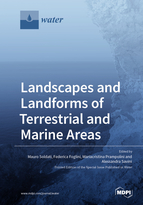Landscapes and Landforms of Terrestrial and Marine Areas
A special issue of Water (ISSN 2073-4441). This special issue belongs to the section "Oceans and Coastal Zones".
Deadline for manuscript submissions: closed (31 October 2020) | Viewed by 64315
Special Issue Editors
Interests: geomorphology; geohazards; mapping
Special Issues, Collections and Topics in MDPI journals
Interests: implementation and management of geodatabase containing geophysical and marine geological data; GIS; habitat mapping
Special Issues, Collections and Topics in MDPI journals
Interests: geomorphometry; submarine geomorphology; seafloor backscatter; habitat mapping
Special Issues, Collections and Topics in MDPI journals
Interests: geomorphology; marine geology; benthic habitat mapping
Special Issues, Collections and Topics in MDPI journals
Special Issue Information
Dear Colleagues,
In most cases, the landscapes and landforms of emerged and submerged areas are investigated separately. Only recently, on-shore geomorphological data have been increasingly integrated with submerged dataset for paleo-environmental reconstructions and land management purposes. Near-shore areas, in particular, are jointly analyzed due to the increasing concentration of human activities that have significant negative impacts on landscapes and habitats.
Modern advances in geo-acoustic and optical full-coverage mapping of both seafloor and near-shore areas, supported by groundthruting information, allow us to acquire large amount of remote and direct data, also in combination with onshore data. Hence, the production of detailed and accurate maps of seabed morphology and substrate can deeply foster integrated studies of emerged and submerged landscapes and landforms.
The aim of this Special Issue is to collect contributions that can demonstrate how the integration of emerged and submerged dataset is unquestionably beneficial, in a wider perspective, for geomorphological research. The manuscripts should focus on the description and analysis of terrestrial and marine landscapes and landforms, with special emphasis on coastal environments and recently submerged areas due to sea level rise. Furthermore, comparisons of terrestrial landforms and processes which have analogous underwater and vice versa would be welcome.
In particular, contributions dealing with the following topics are invited:
- Terrestrial and marine landforms in near-shore areas, coupling terrestrial and marine datasets for geomorphological reconstruction, hazard assessment, benthic habitat mapping, environmental conservation, coastal management, Marine Spatial Planning, etc.
The integrated analysis of submarine and terrestrial landforms provides a fundamental contribution to the reconstruction of Late Quaternary landscapes and for assessing geohazards, especially considering the effects of climate change and sea level rise. Furthermore, the knowledge of both terrestrial and near-shore landforms is the basis for mapping the benthic habitats and monitoring their status with reference to the coastal processes.
- Landscapes and landforms of recently submerged areas, e.g., during the post-LGM marine transgression and possible comparison with present terrestrial areas.
Most of the present marine areas, down to a depth of ca. 130 m, were emerged during the last glacial cycle and modelled by subaerial processes that shaped the landforms occurring on the seafloor today. These areas also hosted pre-historic and historic human settlements—as demonstrated by archaeological remains, pollens, bones or other remains in the sediments, caves, etc.—that can be discovered and investigated.
- Analogous landforms in submarine and terrestrial environments.
This includes description and analysis of landforms that are analogous in terms of processes by which they were modelled; or analogous in terms of similar shape, but possibly related to different kind of processes or to the alternation of subaerial and submarine processes due to sea level oscillations.
Prof. Mauro Soldati
Dr. Federica Foglini
Dr. Mariacristina Prampolini
Prof. Alessandra Savini
Guest Editors
Manuscript Submission Information
Manuscripts should be submitted online at www.mdpi.com by registering and logging in to this website. Once you are registered, click here to go to the submission form. Manuscripts can be submitted until the deadline. All submissions that pass pre-check are peer-reviewed. Accepted papers will be published continuously in the journal (as soon as accepted) and will be listed together on the special issue website. Research articles, review articles as well as short communications are invited. For planned papers, a title and short abstract (about 100 words) can be sent to the Editorial Office for announcement on this website.
Submitted manuscripts should not have been published previously, nor be under consideration for publication elsewhere (except conference proceedings papers). All manuscripts are thoroughly refereed through a single-blind peer-review process. A guide for authors and other relevant information for submission of manuscripts is available on the Instructions for Authors page. Water is an international peer-reviewed open access semimonthly journal published by MDPI.
Please visit the Instructions for Authors page before submitting a manuscript. The Article Processing Charge (APC) for publication in this open access journal is 2600 CHF (Swiss Francs). Submitted papers should be well formatted and use good English. Authors may use MDPI's English editing service prior to publication or during author revisions.
Keywords
- Coastal and marine environments
- Integration of terrestrial and marine datasets
- Geomorphology
- Geophysics
- Geoarchaeology
- Paleo-environmental reconstructions
- Climate change and sea level rise
- Geohazards
- Geomorphological Mapping
- Benthic habitats
- Environmental protection and conservation









